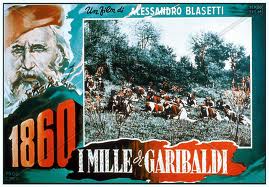As a Romance Languages major who chose Italian as one of my specialties, I’m lucky that the few upper-level Italian courses we’re offered are so interesting! Many, like this one, are cross-listed courses, so I get to take class with not only Italian students (it’s a pretty small department – the few of us overlap a lot!) but also a lot of new faces. The course is taught in English but incorporates a substantial amount of Italian vocabulary related to film studies and Italian culture and history.
We began our first week with an introduction to cinematic terminology and then practiced applying that terminology to closely analyze the various visual, sound, and editing elements of a shot to draw conclusions about the scene or film as a whole. We needed to learn to read a film, or even each individual shot, like we would a text for many other classes.
We then moved to political theory, with a discussion of what makes and nation and then a lesson on the historical context for our first film, 1860 directed by Alessandro Blasetti. Although I knew much of this from previous classes on Italian fascism, the history of the unification of Italy and the rise and fall of fascism always fascinates me. Italy was made up of many political kingdoms until the middle of the 19th century, when Giuseppe Garibaldi invaded Sicily with only 1000 soldiers and the help of local unification fighters, known as picciotti and successfully unified Italy under the parliamentary monarchy of Piedmont, although there remained a clear division between the industrial north and the rural south of Italy, resulting in mass migration northwards in search of work. Italy was united, but weakly, and it is to this “weakness” that the successful rise of fascism is often attributed. World War 1 brought staggering casualties and economic hardship to Italy, and the following decades saw increasing unrest from the working class.
Mussolini’s vision offered a popular and attractive escape from the troubles of contemporary society – an Italy returned to its imperial grandeur and united by a fervent national pride. This necessitated defining the essence of “Italian-ness,” a task which started with the family outward. Fascism was successful in Italy in large part because it worked simultaneously from the top – down and from the bottom – up. Mussolini was a master propagandist and invested extensively in local cinema beginning in the 1920s. Although the message of these fascist newsreels and films came from the top on down, the effects was very grassroots in style, infiltrating the daily routine and entertainment of the average people with fascist ideals, most essentially the value of the hetero-normative, working family unit as the most essential building block of the fascist state.
1860 is considered one of the most quintessential fascist films in Italian cinema. It glorifies the unification of Italy as a proud and patriotic success and celebrates men as idealistic nationalists fighting to defend their home and women as pure, doting mothers – or future mothers – of the next generation of proud Italian fascists. Blasetti incorporates natural imagery throughout the film to emphasize the authenticity and purity of his vision of Italy and contrast it with the death and destruction that he shows as the result of foreign rule. As a class, we analyzed how details such as the establishing shots of nature, the recurrence of dark, cloudy long shots, low angle shots and staging of actors contributed to the overall effectiveness and tone of various crucial scenes.
